Function Definition
Last Updated on : 2024-06-21 04:01:25download
Types of data point (DP)
Tuya Developer Platform allows you to define functions with six data types, including bool, value, enum, fault, string, and RAW.
Bool: Binary variable (true or false), such as the function of the switch.
Value: Apply to the data that can be linearly adjusted, such as adjusting the temperature.
Enum value: A custom finite set of values, such as the high, medium, and low levels.
Fault: specified for fault report and statistics. Support Only report when multiple faults occur.
Char type: It indicates data transfer in CHAR type.
RAW type: It indicates data transfer in a RAW binary format.
Standard DPs
Standard DPs
| Data point | Identifier | Transmission Type | DP type | DP property | Remarks |
|---|---|---|---|---|---|
| Switch | switch_led | Send/report | Bool | ||
| Mode | work_mode | Send/report | Enum | The enum values include white, color, scene, and music. | |
| Brightness | bright_value | Send/report | Integer | The value ranges from 10 to 1,000, with a pitch of 1 and a scale of 0. | |
| Color temperature | temp_value | Send/report | Integer | The value ranges from 0 to 1,000, with a pitch of 1 and a scale of 0. | |
| Colored light | colour_data | Send/report | String | ||
| Scene | scene_data | Send/report | String | ||
| Countdown | countdown | Send/report | Integer | The value ranges from 0 to 86400, with a pitch of 1 and a scale of 0. Unit:s. | |
| Music | music_data | Send only | String | ||
| Adjust | control_data | Send only | String | ||
| Smart Scene | scene_list | Report only | RAW | ||
| Select a scene | scene_select | Send/report | RAW | ||
| Scene loop | scene_combine | Send/report | RAW | ||
| Scene reset | scene_factory | Send/report | RAW |
Description of DPs
DP20(1): on/off (required)
Type: Boolean
Value: true/false. Turn on or turn off
Example: {“20”:true}
DP21(2): mode (required)
Type: enum
Value: ”white”/”colour”/”scene”/”music”
White light mode/color light mode/scene/music light
Example: {“21”:“scene”}
Note:
White light, colored light, scene, and music light are displayed at the bottom tab on the mobile app.
- White light: determined by two DPs together,
modeandbrightness. - Colored light: determined by two DPs together,
modeandcolor. - Scene: determined by two DPs together,
modeandscene. - Music light: determined by two DPs together,
modeandmusic. - Delay time: determined by the DP
timer. - Schedule: determined by the enablement of cloud timing in the advanced cloud functions.
DP22(3): brightness
Type value
- Value: 10 – 1000
- Example: {“22”:670 "}
Note: The brightness range of 10 to 1,000 corresponds to the value range of 1% to 100% on the mobile app. The minimum value is 1%.
DP23(4): color temp
Type value
Value: 0-1000
{“23”:797"}
Note: The color temperature range is from 0 to 1,000. It is defined between the coolest white and warmest white. The actual color temperature depends on the bead specifications, such as 2700K to 6500K.
DP24(5): color
- Data type: string
- Value: 000011112222
- 0000: H (hue: 0–360, 0X0000–0X0168)
- 1111: S (saturation: 0–1000, 0X0000–0X03E8)
- 2222: V (value: 0–1000, 0X0000–0X03E8)
Example: {“24”:“000011112222”}
HSV value is 00DC, 004B, and 004E in hex format. After converting them to the decimal format, you will get 220°, 75%, 78%.
Note: Color values are output in HSV format. Alternatively, you can convert values to the RGB format. For more information, visit color conversion.
You can obtain RGB (R,G,B): (HEX)(32,64,C8),(DEC)(50,100,200).
DP25(6): the scene
Data type: string
Value: 0011223344445555666677778888
00: the scene No.
11: the unit switch interval (0–100)
22: the unit change time (0–100)
33: the lighting mode. 0: static. 1: jumping. 2: gradient.
4444: H (hue: 0–360, 0X0000–0X0168)
5555: S (saturation: 0–1000, 0X0000–0X03E8)
6666: V (value: 0–1000, 0X0000–0X03E8)
7777: white light brightness (0–1000)
8888: temperature value (0–1000)
Note: Each digit that ranges from 1 to 8 in the preceding example specifies a unit and a group.
Example: {"25":"010b0a02000003e803e8000000000b0a02007603e803e8000000000b0a0200e703e803e800000000"}
01: It indicates the scene ID is 01.
0b: It indicates the transition interval between lighting modes is 0.
0a: It indicates the lighting mode duration is 10.
02: It indicates the lighting mode is gradient.
0000: It indicates hue is 0x0000.
03e8: It indicates saturation. It ranges from 0 to 1,000, corresponding to 0x0000 to 0x03E8.
03e8: It indicates value. It ranges from 0 to 1,000, corresponding to 0x0000 to 0x03E8.
0000: It indicates brightness. It ranges from 0 to 1,000.
0000: It indicates color temperature. It ranges from 0 to 1,000.
DP26(7): timer
Type value
Value: 0-86400
The data unit is second, which corresponds to a value of 60 for one minute, and the maximum setting is 86400=23 hours and 59 minutes.
0: It indicates the timer is turned off.
Example: {"26":"120"} indicates 120 seconds.
120 s is 2 mins.
Note:
The time delay feature is available for users only after you add this DP to your product.
DP27(8): music
Data type: string
Value: 011112222333344445555
The change mode (0: jumping. 1: gradient.)
1111: H (hue: 0–360, 0X0000–0X0168)
2222: S (saturation: 0–1000, 0X0000–0X03E8)
3333: V (value: 0–1000, 0X0000–0X03E8)
4444: indicates brightness. It ranges from 0 to 1,000.
5555: the temperature value (0–1000)
Example: {"27":"1007603e803e800120025"}
The change mode (0: jumping. 1: gradient.)
Sample description:
The change mode: 0: jumping. 1: gradient.
0076: It indicates hue is 0x0076.
03e8: It indicates saturation is 0x03E8.
03e8: It indicates value is 0x03E8.
0012: It indicates brightness is 18%.
0025: It indicates color temperature is 37%.
Note: *8This DP and the DP mode together determines whether the music light is available for users.
DP28(9): adjust
Data type: string
Value: 011112222333344445555
The change mode (0: jumping. 1: gradient.)
1111: H (hue: 0–360, 0X0000–0X0168)
2222: S (saturation: 0–1000, 0X0000–0X03E8)
3333: V (value: 0–1000, 0X0000–0X03E8)
4444: indicates brightness. It ranges from 0 to 1,000.
5555: the temperature value (0–1000)
Example: {"27":"1007603e803e800120025"}
The change mode: 0: jumping. 1: gradient.
0076: It indicates hue is 0x0076.
03e8: It indicates saturation is 0x03E8.
03e8: It indicates value is 0x03E8.
0012: It indicates brightness is 18%.
0025: It indicates color temperature is 37%.
Note: This DP is used to receive commands from the cloud when users control the light on the mobile app.
DP51: Scene configuration
Type: RAW
Value: 0011112222334444400111122223344444…
00: Scene number (number in the scene library)
1111: Brightness
2222: Color temperature
33: Speed gear
Example: {“51”: “1e03e801f400000000c007701f401000001603e801f400000000603e801f420000001d02b501f400000000503e801f430000001903e801f400000000003e801f40000000”}
1e: Scene number (Tuya scene library number 30)
03e8: Brightness 1000
01f4: Color temperature 500
00: Speed gear 100 means the first-level gear, 10 means the second, 20 means the third, and 30 means the fourth, 01 means the gears of the first to the fourth cycle in turn.
Note:
After the device is successfully connected to the Internet, a DP point report must be performed first, and the panel will configure the corresponding scene interface according to the reported scene serial number.
DP 52: Scene selection
Type: RAW
Value: 00111122223344444
Sample:
{“52”:1d03e801f40000000"}
1d: scene number, 1d is converted into a system of 29
03e8: brightness (100%)
01f4: color temperature
00: speed gear 1, 00 means speed first gear, 10 means speed second gear, 20 means the third speed gear, 30 means the fourth speed gear, 01 means the 1st to 4th gears cycle in turn.
Note:
The DP is used to configure the parameters of a certain scene and make the device enter this scene.
DP53: Scene loop
Type: RAW
Value: 00112233445566…
00: scene number, 11: scene number, send as many scenes as you choose
Sample:
{“53”:0c1d0519"}
0c: Scene 12
1d: Scene 29
05: Scene 5
19: Scene 25
Note:
The device will start to execute each scene according to the selected scene number after receiving this instruction.
DP 54: synchronize unlocking methods
Type: RAW
Value: 00
00: the scene No
Sample:
{“104”:“25”}
25: Scene 25
Note: After receiving this instruction, the device restores the corresponding scene to the default value and performs an active report through DP: scene selection.
Custom functions
You can customize functions that are not supported by standard functions. Data point (DP) is the abstract representation of function, and each function can be defined by different function types. Six data types, namely Boolean, Integer, Enum, Fault, Char type, and RAW type.
Custom DP does not support third-party voice and third-party cloud docking. If you have good suggestions for the expansion of our standard DP. It is recommended to submit a ticket. Tuya will help create standard data functions as soon as possible.
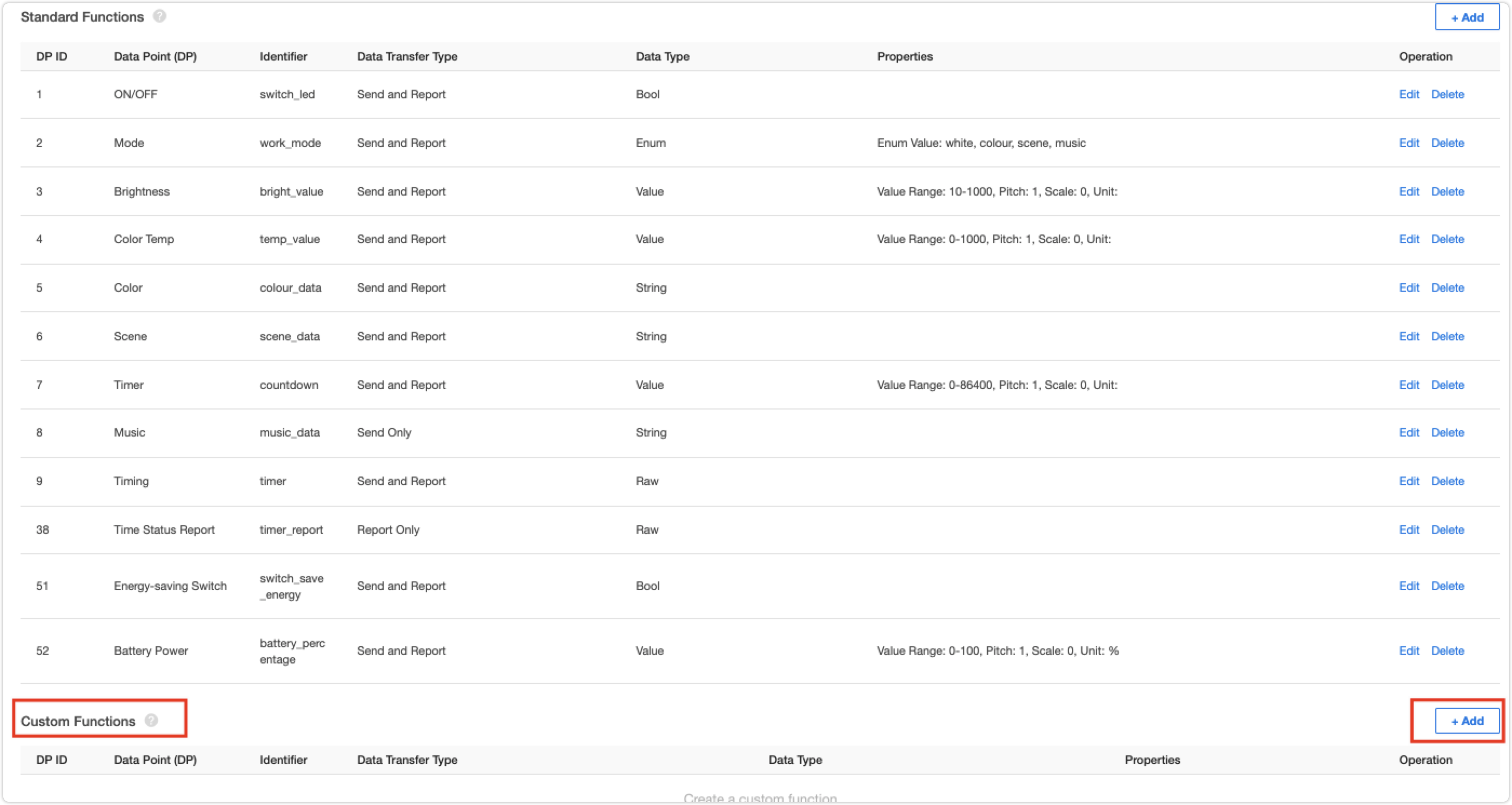
DP ID is synonymous with the function, and the function name is used to quickly distinguish the function represented by the function.
The identification name is the unique identity that distinguishes functions in the product software.
You can select the type according to the DPs. The Tuya Developer Platform supports six data types, including Boolean, value, enum, fault, string, and raw.
Bool: Binary variable (true or false), such as the function of the switch.
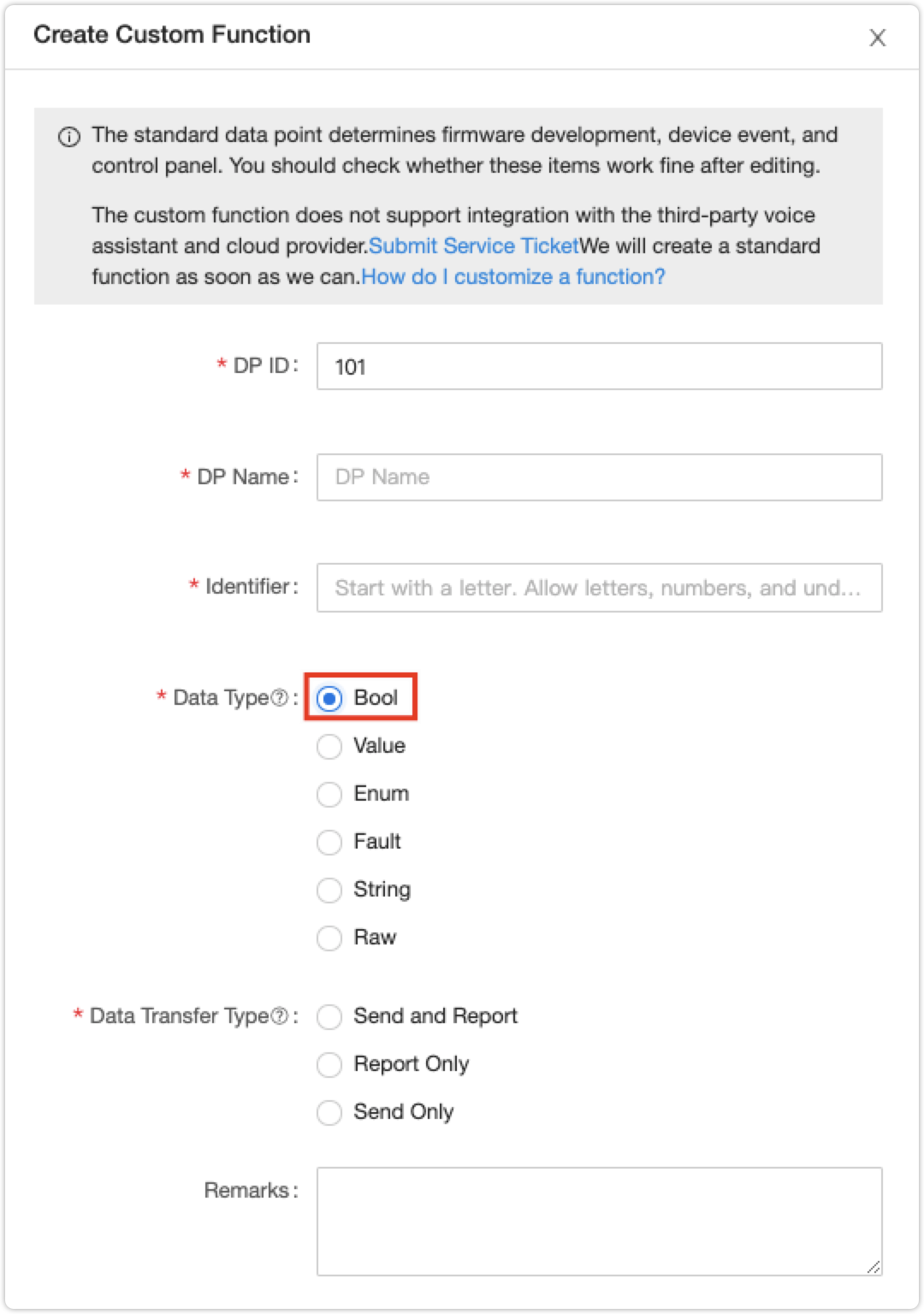
Value: Apply to the data that can be linearly adjusted, such as adjusting the temperature. You should set the value range, spacing, and scale value. The scale value can be set to 0, 1, 2, 3 and transmitted in the exponential conversion of 10, suitable for decimals.
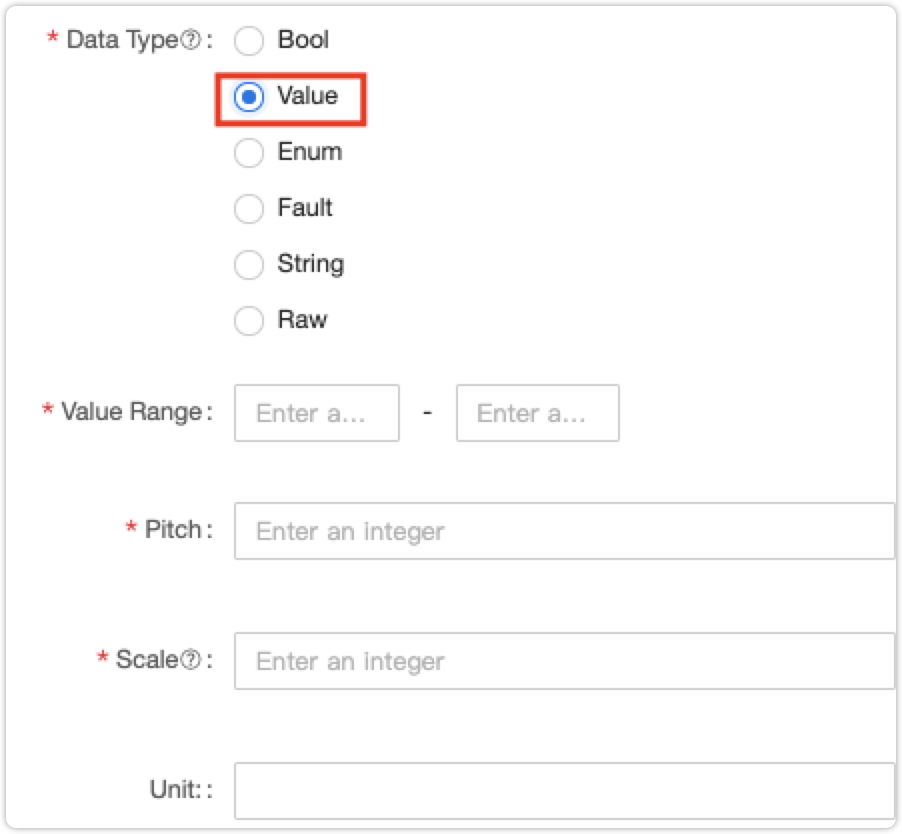
Enum: a self-defined limited set of values, you need to set the enumeration value and confirm with Enter. It supports numbers, letters, and underscores, such as high, mid, and low gears;
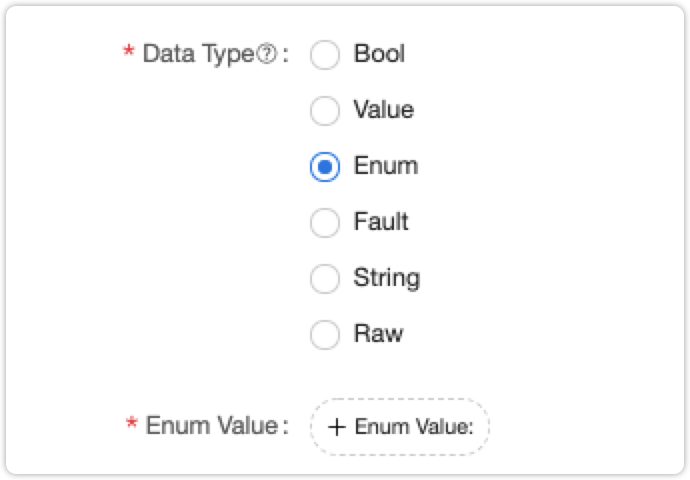
Fault: specified for fault report and statistics. Support Only report when multiple faults occur.

RAW type: It indicates data transfer in a raw binary format.
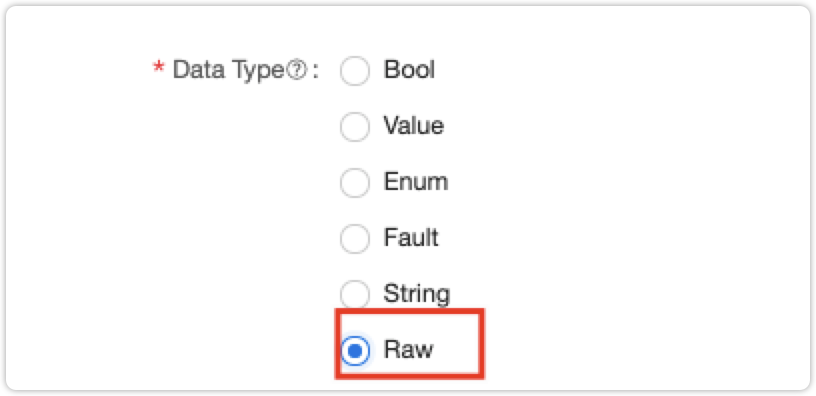
The data transmission type is divided into send and report, send only, and report only. Select a type according to product functions and the panel.
Send and report: Command data can be sent to the device, and device data can be reported to the cloud.
Report only: Data can only be reported from the device.
Send only: Data can only be sent from the cloud.

Cloud functions
Cloud function: It supports cloud timing and jumping page.
Timing allows you to implement functions of on/off timer and weekly schedule without embedded hardware development.
Jumping Page: With a link, users can navigate to another page, such as the online store and user guide.

Is this page helpful?
YesFeedbackIs this page helpful?
YesFeedback





